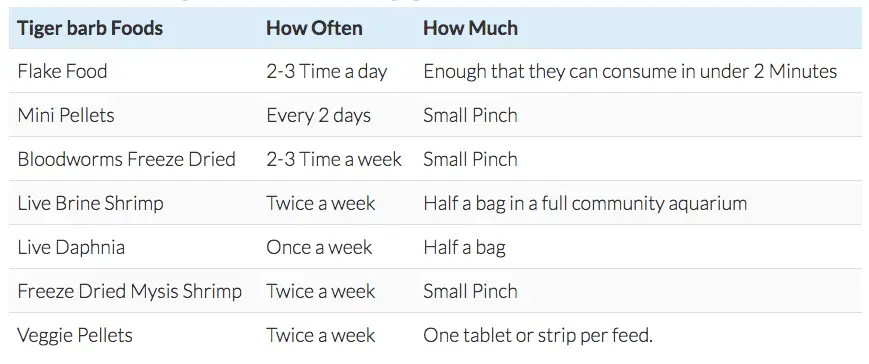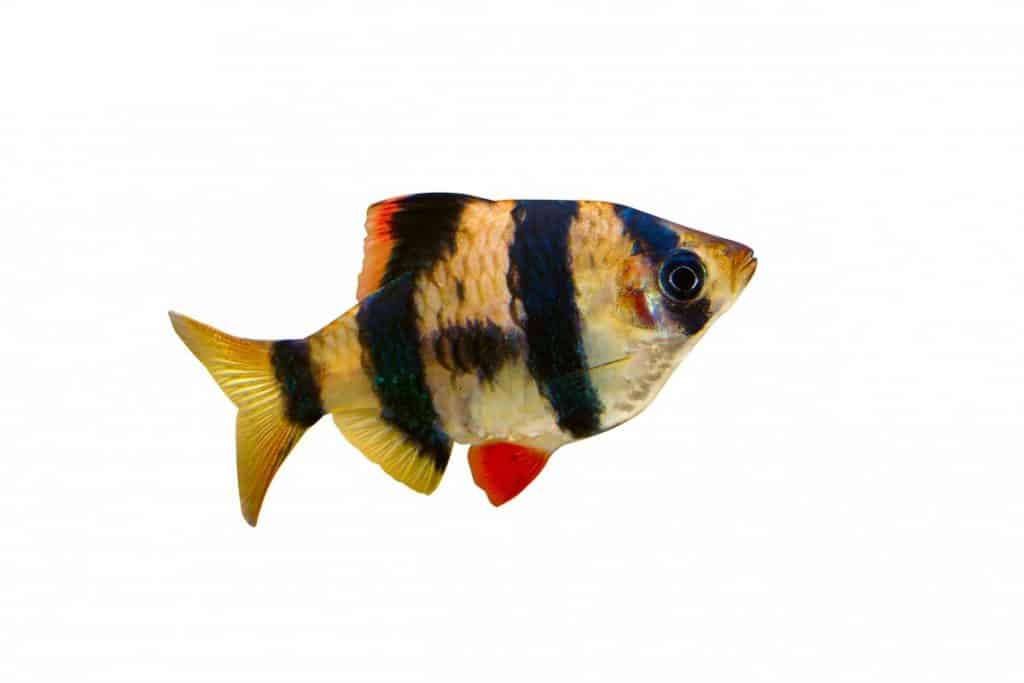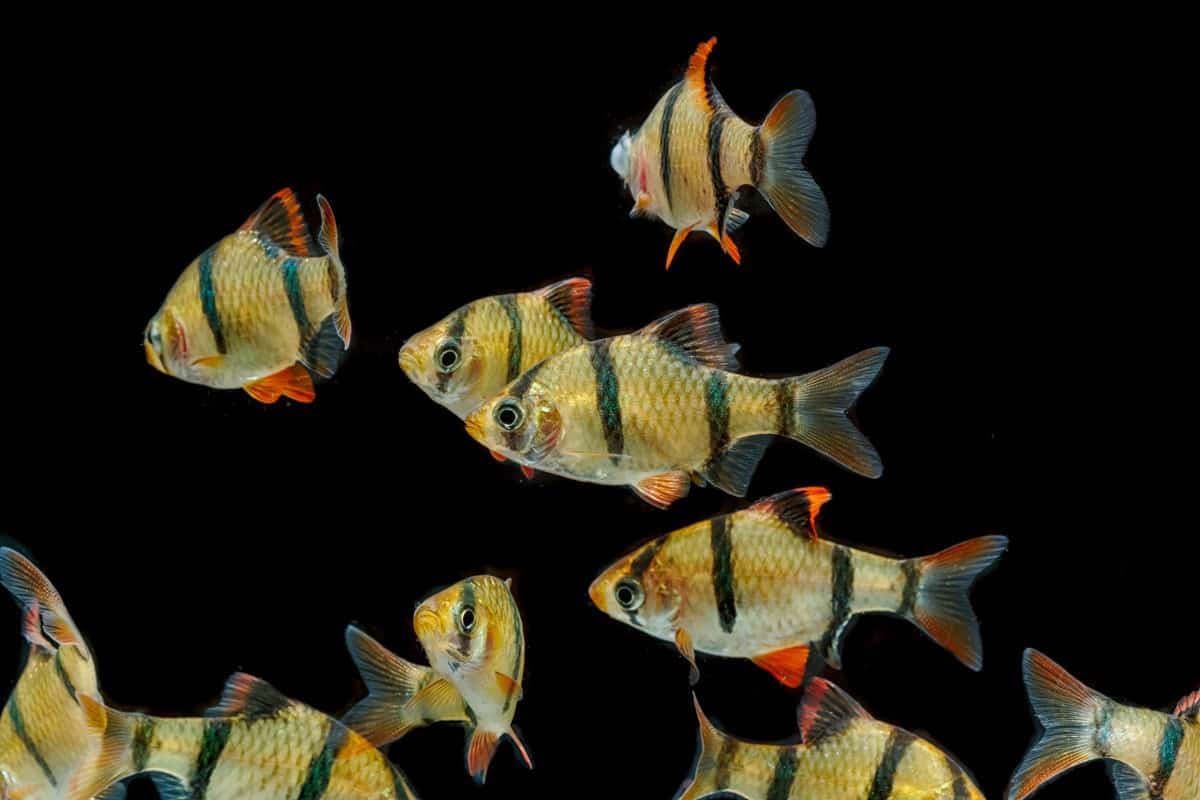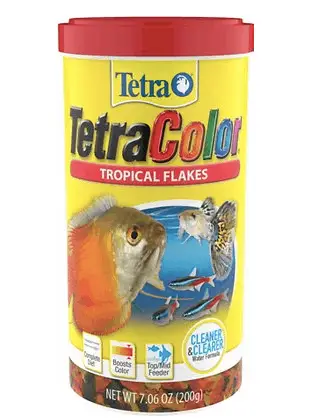The Tiger Barb is an extremely popular and easy to care for tropical freshwater fish species. They are fun to watch, speedy swimmers, and have glorious coloration. They should be kept in groups of six or more, possibly in a species only aquarium, and grow up to around 3 inches or 7 cm in size.
Though Tiger Barbs are easy to care for they do have some specific requirements. These include keeping water at acceptable parameters and also feeding them the correct diet. Correct diet is a requirement of the Tiger Barb in order to ensure they remain healthy, active, and thrive.
What do Tiger Barbs eat? In the wild Tiger Barbs will feed on a variety of natural food sources like insects, vegetation and even small fry. In the home aquarium they will requirer a complete and balanced diet including flake food, freeze dried foods, veggie tablets, live food and mini pellets.
Table of Contents
Below is a Tiger Barb feeding guide

Tiger Barb Natural Diet
Found naturally in the waters of Borneo, Indonesia, and Sumatra, the Tiger Barb is a mid-dweller that inhabits quiet areas. Tree-lined tributaries lined with sand, rocks, and thick vegetation are perfect especially when it comes to satiating their appetite.
Tiger Barbs feed on insects, algae, invertebrates, and detritus from plants, which are all found in abundance in their natural environment. This makes them omnivores who will eat virtually anything, and greedily at that, with aggression often being shown during feeding time.
Tiger Barb Diet In The Home Aquarium
In the home aquarium as in their natural environment, Tiger Barbs will eat anything they are offered. They should, however, be given a varied diet to maintain a healthy immune system and thrive.
Tiger Barb diet should include a high-quality pellet or flake, as well as live and frozen foods such as brine shrimp, bloodworm, and proteins. Cooked vegetables also make a tasty treat that Tiger Barbs will love.
Ideal proteins include beef heart, salmon, mysis shrimp, and brine shrimp. Cooked vegetables include peas, carrots, Brussel sprouts, and pumpkin.

Pellet/Flake – A great everyday food that has a great shelf life. It is made of a mixture of ideal dried ingredients to include in a Tiger Barbs diet.
Brine Shrimp – A tiny crustacean that can be fed live, frozen, or dried to your Tiger Barbs. It is best if feeding the dried version to soak them in water before feeding to hydrate them a little.
Bloodworm – Bloodworm is the small red larvae of the midge fly and can be fed to Tiger Barbs live, frozen, or freeze-dried. It is a very popular treat for most aquarium fish that will be gobbled up and enjoyed.
Mysis Shrimp – Another tiny shrimp-like crustacean, the Mysis Shrimp is another popular treat for many species of fish. Like Brine shrimp, they are available live, frozen, or dried.
Veggie Tablets – Omega One make a fantastic veggie tablet that you can drop into the aquarium or press onto the side of the glass ( My Choice ) and watch them feed from it until its gone. It is very important to introduce some vegetable matter into freshwater fish diet. After all they would be eating vegetation all day long in the wild.
How Often And How Much To Feed Tiger Barbs
In an ideal world, Tiger Barbs should be fed twice a day as much as they can eat in around 3 minutes. However, our schedules do not always allow for this so once a day is also acceptable. Feeding once a day the amount given should be what they can eat in 5 minutes.

Remember, Tiger Barbs are notoriously greedy fish that eat quickly and aggressively. This can mean you may need to adjust feeding schedules, amounts, and methods to suit your particular fish. For example, is one fish, or more, far more aggressive than the others and eating the lion’s share, or do you think they are just eating too much because of their speed?
Good indicators of this being the case would be some or all fish either being obese or emaciated. If this is the case, you will need to re-think feeding. Lower amounts are given for those fish that appear obese for example and try to separate those who may not be getting enough. This will mean you can feed them separately and ensure they get enough nutrition.

Color Enhancing Foods for Tiger Barbs
As stated earlier the Tiger Barb is a gloriously colored fish with its orange body and four black vertical stripes. In fact, it is this coloration that makes them so popular. Keeping this coloration, however, can be problematic, especially if you don’t feed them the correct diet.
We have already mentioned many color enhancing foods such as krill, plankton, vegetables, brine, and mysis shrimp. However, you can also top up the benefits of these with specially formulated color enhancing fish foods. These come in pellet and also flake form and can be highly effective.
Colour enhancing foods usually contain high levels of carotenoids which promote color development when used properly. Carotenoids are any of a class of mainly yellow, orange, or red fat-soluble pigments, including carotene which gives color.
We use TetraminColor Flakes for all our Freshwater fish. They are inexpensive and work well compared with other flake foods on the market today. They especially bring out the colors on our Betta’s.
These foods should not, however, be fed as a staple diet since they are rarely nutritionally complete. They may also when overused cause ‘burning’ which is where patches of color appear. They are, nonetheless, more potent in colour enhancing than any natural food so are definitely worth feeding to Tiger barbs in small but regular doses.
Conclusion: Tiger Barb Diet
Whilst it is true that the Tiger Barb requires the correct nutritional diet to thrive, we have also shown above that this is not difficult to provide. Flake and pellet, for example, including color enhancing are all extremely easy to obtain, whilst live, frozen and dried are not far behind.
What can be a little more difficult, however, is getting the amount of food and how often you feed them just right. This, nonetheless, is fairly easy to address, and with a little experimentation, you’re sure to get it right.
Read ” What time of day should you feed your fish” for more insight into feeding your Tiger barb and other fish correctly.
[author title=”About the Author”]

I have been working in the tropical fish industry for over 30 years now and I’m still learning. Everyday is a school day in this hobby. In my spare time I play golf very badly!




